|
|
 |
Fiche d'espèce de Copépode |
|
|
Calanoida ( Ordre ) |
|
|
|
Diaptomoidea ( Superfamille ) |
|
|
|
Candaciidae ( Famille ) |
|
|
|
Candacia ( Genre ) |
|
|
| |
Candacia norvegica (Boeck, 1864) (F,M) | |
| | | | | | | Syn.: | Candace norvegica Boeck, 1864; Giesbrecht, 1892 (p.425) | | | | Ref.: | | | Giesbrecht & Schmeil, 1898 (p.131); Sars, 1902 (1903) (p.134, figs.F,M); Farran, 1908 b (p.85); Lysholm, 1913 (p.6); Lysholm & Nordgaard, 1921 (p.27); Sewell, 1932 (p.336, Rem.); Wilson, 1932 a (p.138, figs.F,M); Rose, 1933 a (p.251, figs.F,M); Jespersen, 1934 (p.119); 1940 (p.66); Lysholm & al., 1945 (p.41); Farran, 1948 b (n°13, p.3, figs.F,M); Marques, 1953 (p.120, figs.F,M); Grice & Jones, 1960 (p.288, figs.F,M, Rem.); Grice, 1963 (p.178, figs.F,M); Tanaka, 1964 c (p.246, figs.F,M, Rem.: variety); Silas, 1972 (p.649); Lawson, 1977 (p.71, tab.2,3,4, fig.4, 5); Huys & Boxshall, 1991 (p.66, fig.); Mazzocchi & al., 1995 (p.76, figs.F,M, Rem.); Chihara & Murano, 1997 (p.754, Pl.75,77: F,M); Bradford-Grieve & al., 1999 (p.885, 956, figs.F,M); Bradford-Grieve, 1999 b (p.172, figs.F,M, Rem., figs.183,193); Boxshall & Halsey, 2004 (p.85: fig.F); Vives & Shmeleva, 2007 (p.453, figs.F,M, Rem.) |  issued from : O. Tanaka in Publs Seto Mar. Biol. Lab., 1964, XII (3). [p.247, Fig.228]. Female (from Izu region, Japan): a, habitus (dorsal); b, last thoracic segment and urosome (left lateral side); c, proximal portion of A1; d, P5. g, h, juvenile (urosome and P5, respectively). Nota: Cephalothorax 2.81 mm; abdomen 0.82 mm. Cephalothorax about 3 times as long as wide. Lateral corner of the last thoracic segment produced into an acute process extending about to the middle of the genital segment. Abdominal segments and caudal rami in the proportional lengths 52 : 17 : 9 : 22 = 100. Genital segment armed with a small process on each side of the lateral margin; these spines are reported to be equal in size by Sars or Wilson but in the present specimen the spine on the left side is longer than that of the right. There is a slight difference in the armature of P5 by comparison with Sars. Male: e, last thoracic segment and urosome (dorsal); f, P5. Nota: Cephalothorax 2.50 mm; abdomen 0.75 mm. The 2nd, 3rd and 4th abdominal segments with each a tuft of hairs on the right distal corner. In P5 the distal segment of the exopod of the right leg more voluminous than that figured by Sars. The distal segment of the left leg with a spine on the inner proximal margin.
|
 issued from : Bradford-Grieve J.M. in The Marine Fauna of New Zealand: Pelagic Calanoid Copepoda. National Institute of Water and Atmospheric Research (NIWA). NIWA Biodiversity Memoir, 111, 1999. [p.173, Fig.123]. Female: A, last thoracic segments and urosome (dorsal); B, urosome (left side); C, exopod segment 3 of P2; D, P5. Nota: The female genital somite of the Southwest Pacific specimens appears to differ slightly from the description by Sars (1903) in that the swollen anterior part is bordered by small hairs. Male: E, last thoracic segments and urosome (dorsal); F, dorso lateral view of anterior urosome; G, right A1; H, P5.
|
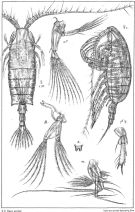 issued from : G.O. Sars in An Account of the Crustacea of Norway. Vol. IV. Copepoda Calanoida. Published by the Bergen Museum, 1903. [Pl.LXXXIX]. Female. Nota: R = rostrum; M = Md; m = Mx1.
|
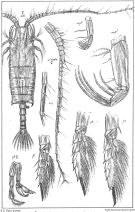 issued from : G.O. Sars in An Account of the Crustacea of Norway. Vol. IV. Copepoda Calanoida. Published by the Bergen Museum, 1903. [Pl.XC]. Female & Male. Nota: mp1 = Mx2; mp2 = Mxp
|
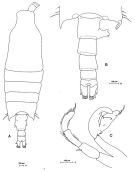 Issued from: M.G. Mazzocchi, G. Zagami, A. Ianora, L. Guglielmo & J. Hure in Atlas of Marine Zooplankton Straits of Magellan. Copepods. L. Guglielmo & A. Ianora (Eds.), 1995. [p.77, Fig.3.9.1]. Female: A, habitus (dorsal); B, urosome (dorsal). Nota: Proportional lengths of urosomites and furca 48:21:15:16 = 100. In dorsal view, genital somite bears short bifid processes at midpoint of lateral margins (right process shorter than left; above bifid processes, genital somite bears tufts of hairs on either side. Male: C, P5. Nota: Proportional lengths of urosomites and furca 28:19:19:11:8:15 = 100.
|
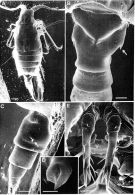 Issued from: M.G. Mazzocchi, G. Zagami, A. Ianora, L. Guglielmo & J. Hure in Atlas of Marine Zooplankton Straits of Magellan. Copepods. L. Guglielmo & A. Ianora (Eds.), 1995. [p.78, Fig.3.9.2]. Female (SEM preparation): A, habitus (dorsal); B, genital somite (dorsal); C, urosome (lateral right side); D, detail of bifid process on genital somite (arrows in B and C); E, P5. bars: A 0.200 mm; C 0.100 mm; B, E 0.050 mm; D 0.010 mm.
|
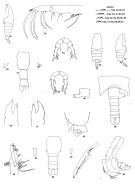 issued from : G.D. Grice & E.C. Jones in Pacific Science, 1960, XIV (3). [p.289, Figs.46-65]. Female: 46, habitus (lateral left side); 47, urosome (dorsal); 48, left genital spinous process (lateral view); 49, right genital spinous process (lateral view); 50, 51, edge biting of mandibular blades from one individual, showing unlike basal teeth; 52, Mx1; 53, Mx2; 54, P5 (with 2 external spinous processes on each foot); 55, P5 (showing 3 external spinous processes on one foot and 2 on the other); 63, urosome (dorsal); 64, 65, genital spinous process (left and right, respectively). Male: 56, habitus (dorsal); 57, idem (lateral right side); 58, 4th and 5th thoracic segments and genital segment (dorsal); 59, genital segment (ventral); 60, 4th and 5th thoracic segments and genital segment (right lateral oblique view); 61, right A1 (segments 17 through 19); 62, P5. Figures 46-62: Pacific specimens; 63-65: Atlantic specimen.
|
 Issued from : R.B.S. Sewell in Mem. Indian Mus., 1932, X (continued). [p.337, Fig.110]. As Candacia norvegica var. tropicaFemale (from Laccadive Sea): a, urosome (dorsal); b, proximal segments of A1; c, Mx2; d, P5.
|
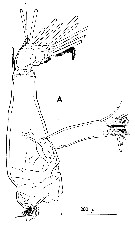 issued from : R. Huys & G.A. Boxshall in Copepod Evolution. The Ray Society, 1991, 159. [p.66, Fig.2.2.13, A]. From Norway: Christiana Fjord, Sars collection: A, A2.
|
 Issued from : J.M. Bradford-Grieve, E.L. Markhaseva, C.E.F. Rocha & B. Abiahy in South Atlantic Zooplankton, edit. D. Boltovskoy. 1999, Vol. 2, Copepoda; [p.1065, Fig. 7.370: Candacia nprvegica ]. Gns = genital segment.
| | | | | Ref. compl.: | | | Pearson, 1906 (p.29); Wilson, 1942 a (part., p.175); Sewell, 1948 (p.350, 408, 496, 506); Mazza, 1966 (p.72); Roe, 1972 (p.277, tabl.1, tabl.2); Bainbridge, 1972 (p.61, Appendix Table III: occurrence); Falconetti & Seguin, 1977 (p.188); Pipe & Coombs, 1980 (p.223, Table II, vertical occurrence); Vives, 1982 (p.294); Madhupratap & Haridas, 1986 (p.105, tab.1); Go & al., 1997 (tab.1, as Canadacia: lapsus calami); Holmes, 2001 (p.30); Beaugrand & al., 2002 (p.179, figs.5, 6); Gaard & al., 2008 (p.59, Table 1, N Mid-Atlantic Ridge); Benedetti & al., 2016 (p.159, Table I, fig.1, functional characters); Belmonte, 2018 (p.273, Table I: Italian zones) | | | | NZ: | 15 + 1 douteuse | | |
|
Carte de distribution de Candacia norvegica par zones géographiques
|
| | | | | | | | | | | | | | | | Loc: | | | Angola, G. of Guinea, off Lagos, off Morocco-Mauritania, Canary Is., Caribbean, Sargasso Sea, Woods Hole, off E Newfoundland, Greenland Sea, S Strait of Davis, S Iceland, off Ireland (S & W), off W Sotland, Norway, Wyville Thomson Ridge (60°N), Lofoten Is., North Sea, Bay of Lübeck, ? W Medit. (Ligura & Tyrrhenian Seas), Indian (E Laccadive Is.), Pacif. (N central), Japan (Izu region), ? [Philippines, China Seas, Japon, Aleutian is., Hawaii, Central America, W Equador, S Galapagos , Chile (in Wilson, 1942 a , 1950, p.181) et (in Fagetti, 1962, p.33)], Straits of Magellan, SE Australia, New Zealand (SW North Island, E South Island) | | | | N: | 38 (Sub-Antarct.: 1; N Atlant.: 24; ? Medit.; S Atlant.: 3; Indian: 3; Pacif.: 6) | | | | Lg.: | | | (36) F: 3,14-2,9; M: 2,96-2,82; (45) F: 3,35-3; M: 3,2-2,9; (65) F: 3,2; M: ±3,2; (120) F: 3,63; M: 3,25; (149) F: 3,24-2,28; M: 2,68; 3,23; (199) F: 2,74; (909) F: 2,75-3,1; M: 2,6; {F: 2,28-3,63; M: 2,60-3,25}
The mean female size is 3.121 mm (n = 11; SD = 0.2654), and the mean male size is 2.982 mm (n = 9; SD = 0.2497). The size ratio (male : female) is 0.95 (n = 6; SD = 0.0462). | | | | Rem.: | épi-mésopélagique.
Les localisations dans le Pacifique établies par Wilson (1942 a, 1950) sont considérées comme erronées (in Fleminger & Bowman, 1956, p.332); Grice & Jones (1960) signale cette espèce dans le Pacif. central N (37°44 N, 165°W), et Tanaka (1964 c) au Japon, Go & al., 1997 à Okinawa.
La signalisation de cette espèce dans le Chenal Liguro-provençal nécessite confirmation.
Voir aussi les remarques en anglais | | | Dernière mise à jour : 18/01/2021 | |
|
|
 Toute utilisation de ce site pour une publication sera mentionnée avec la référence suivante : Toute utilisation de ce site pour une publication sera mentionnée avec la référence suivante :
Razouls C., Desreumaux N., Kouwenberg J. et de Bovée F., 2005-2025. - Biodiversité des Copépodes planctoniques marins (morphologie, répartition géographique et données biologiques). Sorbonne Université, CNRS. Disponible sur http://copepodes.obs-banyuls.fr [Accédé le 02 juillet 2025] © copyright 2005-2025 Sorbonne Université, CNRS
|
|
 |
 |













